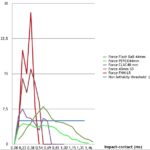KLACC®: WHAT DIFFERENCES WITH DEFENCE BALLS

We bring our point of view based on the conduct of several studies in terminal ballistics and experiments.
VOCABULARY
FIREARMS AND AMMUNITION:
Flash Ball: Is the brand of two-shot launcher manufactured by French company Verney Carron, it has been the precursor of kinetic launchers since 1992 in 44 caliber.
Caliber 44: exists in two versions of civilian weapons:
44 * 83 mm with a maximum energy of 135 Joules (European C category)
44 * 83 SP with a maximum energy of 240 Joules (European B category).
Due to its diameter, the probability of intra-orbital center impact is low. For our 44 KLAC (Kinetic Low Attrition Crushing Core) projectile, since the initial diameter of 44.4 mm, the effective impact area exceeds 60 mm at only the third of the maximum force when it is expanded on impact. For other ball projectile make of rubber foam, this 60 mm diameter is only achieved at the maximum force, making the impact significantly more harmful.
44*83 does exists anecdotally in riffled version – category A.(military weapons)
Caliber 40: 40mm * 56mm, is the low speed version for individual grenade launcher (Category A – war weapons). Barrel riffling impose an ogival projectile holded with a hard rear part for making it rotate. For that reason, the diameter of the head is generally smaller (usually 37mm) and is also not too deformable to prevent the head of the projectile tuching the barrel. Its impact diameter is usually close to 40mm.
LBD: Defensive Bullet Launcher is the name used by the French Ministry of the Interior during tenders for 40mm single-shot riffled launchers (European Category A), it has been in service in the French national police since 2008. In France, this acronym is repeated by the press and the public often undifferentiated with the name “Flash Ball” which is an European CatB weapon.
TECHNICAL TERMS
TRAJECTORY
Gyro-stabilisation: The riffled guns lead the projectiles in rotation and thus make it possible to stabilise it on his trajectory. This stabilising mode imposes a riffling grip ring made of relatively hard and resilient material (thus deforming little on impact). It is therefore obviously more difficult to ensure non-lethality with projectiles of this type.
Arrow projectile: Smooth-bore weapons do not allow gyro-stabilisation; their trajectory can then be ensured either by a symmetrical aerodynamics (round ball), or by aerodynamical stabilised fin (like an arrow); it is then an arrow projectile and no longer a bullet.
PARAMETERS
Energy: projectile mass at impact x impact velocity x impact velocity / 2
Force: mass x deceleration at impact (independent of the impact surface)
Constraint: force / impact surface (average value on the impact surface),
Gradient (force): is the rising slope of the force until its maximum. The stronger the gradient, the more the projectile causes damage with the risk of perforation or breakage.
Non lethality: this criterion is difficult to establish since the human constitution can vary by a factor of 5; that is to say, for the cranial thickness in particular some really have the head harder than others!
A Franco-German study published in 1991 established a maximum acceptable force of 5KN for a 40 mm diameter impact (MR35 PUNCH-MANURHIN rubber projectile) whith a good margin of safety.
This value corresponds to an average constraint of less than approximately 5 kPa for head injuries.
MEASURES
Hardness: it is usually expressed in Shore A for elastomers. For example, for a 40 Shore rubber foam, its quasi-static hardness will be (40 x density) Shore A. Below 10 Shore A, it passes on the Shore 00 scale (very deformable materials) usually reserved for mask molding. facials for the cinema.
These values are quasi-static values that do not translate reality into dynamic impact. Some materials harden with speed (this is the case for rubber that can double to hardness equivalent to 50 m / s).
It is for these reasons that we studied the dynamic aspect in the choice of our materials and selected those which retain their properties (and low values: Scale 00) even at high impact speed.
A NEW CONCEPT OF CONTROLLED FORCE
KLACC (Kinetic Low Attrition Crushing Core) projectile is a crush controlled effect projectile which absorbs by self collapsing, a significant part of is own energy at impact.
Our patented process for KLAC allows to apply a similar energy to that of other LBDs: between 130 and 210 Joules in MO version while significantly reducing the damage product. Our aerodynamic design of KLAC projectile induce high drag and fast deceleration (see ammunition data sheet) in purpose to automatically adapt the enforcement response to the threat: rioters coming too close will get it at full speed with 200 Joules where same KLAC-SP round could be used at 25 m to make a dispersion action with around 50 Joules.KLAC-C is the short range version delivering less than 100 Joules at 5 meter and only efficient and accurate up to 15 meters.
At energy equals the KLAC® projectile:
– reduces the impact stress (less than 5 kPa),
– eliminates the wound risks due to the impact of the pellet inherent to the 40mm caliber,
– increases the perceived pain with an impact surface multiplied by more than two for a time 2 times longer,
– avoids the rebound effect (all the energy is delivered).
BECAUSE OF ITS FRAGILE AT IMPACT ARROW STRUCTURE AND THE SELECTED MATERIALS, THE PEFCO TERMINAL BALLISTIC BEHAVIOUR AND THE CONSTRAINT APPLIED DURING IMPACT ARE INDEPENDENT OF ITS SPEED OR DISTANCE. ENERGY IS IN FACT DISSIPATED DURING MORE OR LESS LONGER IMPACT.
